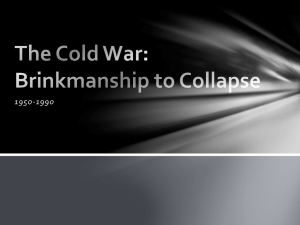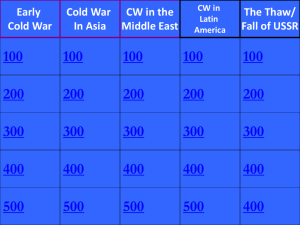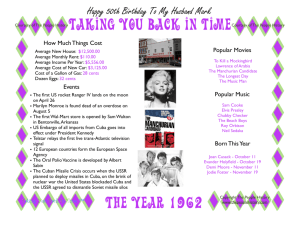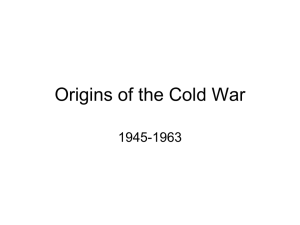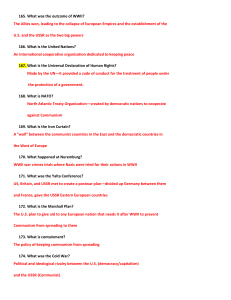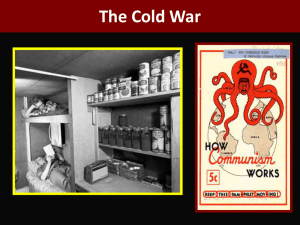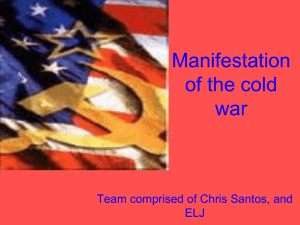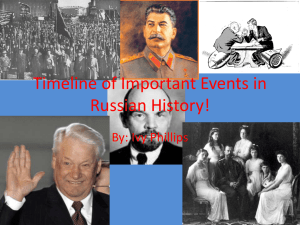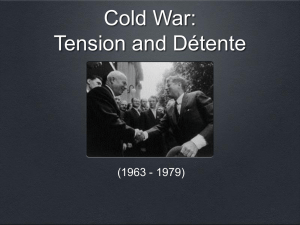Conflicting Superpowers - White Plains Public Schools
advertisement
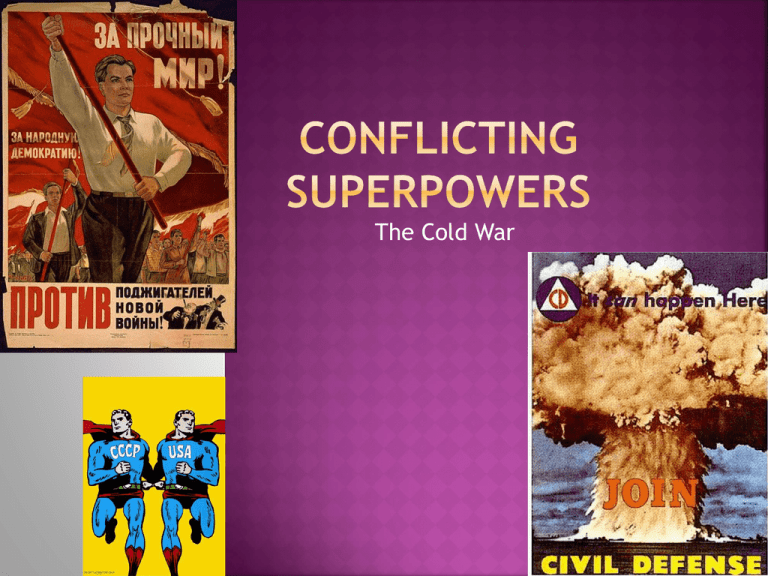
The Cold War 1949 was a key year in the globalization of the Cold War In Europe, NATO was established In the USSR, the Soviets tested their first atomic bomb, eliminating America’s advantage in military technology – and starting a four-decade arms race In China, the civil war between Chiang Kaishek’s Nationalists and Mao Tse-tung’s Communists, which had been raging since the end of the World War II, came to an end The Nationalists fled to the island of Taiwan On the mainland, Mao and the Communists established the People’s Republic of China (PRC) They also allied with the USSR In a matter of months, the Cold War had expanded unimaginably: the two most populous nations on earth, and the two largest nations on the Eurasian landmass, were now joined together under the banner of communism And one of them was armed with atomic weapons Increasingly, the new arena of the Cold War would become Asia, Africa, and Latin America The first sign of this was the Korean War (1950-1953) After World War II, the Korean peninsula had been divided into two zones: a northern communist sector and a southern noncommunist sector In 1950, encouraged by Mao’s victory in China (and promised assistance by Stalin, and especially, Mao), the communist dictator of North Korea, Kim Il Sung, invaded South Korea America’s policy of containment would not allow it to stand by while South Korea was swallowed by the communist north Under the auspices of the United Nations, the United States fought the North Koreans (as well as huge numbers of Chinese “volunteers” who unofficially joined the war) By 1953, the invasion had been turned back, and a cease-fire provided for the continued split of Korea at the original line of division This was the first major conflict of the postwar period, and it killed more than 1.25 million Koreans and Chinese Many of the Koreans were civilians During the 1950s and 1960s, new realities dominated the Cold War The first was a change in Soviet leadership Stalin died in 1953 He was succeeded by Nikita Khrushchev (19531964), then Leonid Brezhnev (1964-1982) Although Khrushchev was not as brutal a dictator as Stalin had been, and could be friendly to the West (unlike Stalin, he traveled abroad frequently and visited the United States), he was extremely unpredictable in foreign affairs Brezhnev was more predictable, but could be more aggressive A second reality was the nuclear arms race From 1945 to 1949, the United States enjoyed a brief monopoly on atomic weapons This changed after 1949, when the Soviets tested their first atomic bomb By the mid-1960s, both superpowers had reached a state of nuclear parity This situation made traditional military planning obsolete It also made international diplomacy incredibly tense Over time, a loose strategic arrangement known as mutually assured destruction (MAD) was reached Both superpowers informally acknowledged that any nuclear exchange would be equally harmful to both sides With a few exceptions, this uneasy arrangement frightened both the United States and the USSR into keeping the peace during most of the Cold War The foundation of the U.S. nuclear policy was the concept of deterrence, whereby the USSR would be deterred from attacking the United States or Western Europe, because of America’s commitment to retaliate by using its large nuclear arsenal Yet it was common during the Cold War for the superpowers to interfere in the political and economic affairs of nations that had recently experienced decolonization It was common during the Cold War to refer to this newly independent region, the developing world, as the Third World because the Third World was not inherently part of the Soviet-led communist bloc or the U.S.-led west The Soviets and Chinese enthusiastically tried to spread communism to many parts of Africa, Asia, and Latin America In its effort to contain communism (the containment policy), the United States intervened in many of these areas This gave rise to a way of thinking known as the domino theory: the belief that if one country in a region became communist, all countries in the region would “fall” to communism, like a row of dominoes collapsing Over time, this approach frequently led the United States to choose unsavory allies in the Third World Whether a political leader or party was democratic or popular mattered less than whether he or it was communist or anticommunist Sadly, America supported many dictatorial or authoritarian leaders in the Third World, simply because they opposed communism And Europe’s place of diplomatic dominance had been clearly lost forever to the superpowers as the nationalization of the Suez Canal demonstrated In 1956, Egypt’s nationalization (to convert from private to government property) of the Suez Canal resulted in a major diplomatic crisis, in which the French and British – who owned the controlling shares in the Canal – were humiliated by a SovietAmerican agreement to allow the nationalization to proceed In 1957, the “space race” began, when the USSR launched the first human-made object, Sputnik, into space Because rocket technology was so intimately connected with the nuclear arms race, the Soviet Union’s temporary superiority in this area greatly frightened the West And in 1959, Fidel Castro and his followers overthrew the dictator of Cuba Shortly after coming to power, Castro became a communist and allied himself with the USSR Because Cuba was only ninety miles off the U.S. coast, this greatly altered the strategic equation of the Cold War Within months, Castro had begun to nationalize industry and carry out land reform Castro, along with his second-incommand, the Argentine radical Ernesto “Che” Guevara, also wanted to combat what they considered to be U.S. imperialism in Latin America Accordingly, the Cuban revolutionaries declared themselves to be Marxists and turned to the Soviet Union for assistance Because of its proximity to the United States, Cuba became a Cold War hotspot from 1961 onward, as demonstrated by the Bay of Pigs incident (1961) and the Cuban Missile Crisis (1962) The Bay of Pigs was a failure in foreign policy for the United States The U.S. had aided Cuban exiles in an attempt to invade the island but Castro was aware of the plan and the plan failed However, the Cuban Missile Crisis was a success for American foreign policy The Soviets had placed missiles on the island of Cuba and Kennedy demanded that the missiles be removed or else war would ensue The Soviets withdrew the missiles But domestically, the Castro regime’s record was mixed It is undeniable that Cuba modernized under Castro, and the gap between rich and poor that had prevailed under Batista, the former dictator, narrowed considerably Educational levels also improved, and women (at least officially) were treated with greater equality than they had been earlier However, Castro’s regime had been rigidly dictatorial and has violated human rights The most dangerous phase of the Cold War came during the early 1960s From 1960 -1962, the superpowers came closer to all-out war than at any other point in time Because both sides had a full-scale nuclear capacity, any such war would have been globally devastating Ironically, the United States and the USSR were preparing for major peace talks in the summer of 1960 In May, however, an American spy plane, the U-2 piloted by Francis Gary Powers, was shot down over the Soviet Union This incident increased tensions dramatically – although because the Soviets had known about American spy flights for years, whether or not they were truly upset or using the incident as anti-American propaganda remains unclear As mentioned earlier, in April 1961, the United States’ newly elected president, John F. Kennedy gave his approval to the Bay of Pigs operation, in which the Central Intelligence Agency supported an anticommunist Cuban force’s attempts to invade Cuba and depose Castro The Bay of Pigs operation failed miserably and embarrassed the United States badly Also, in April 1961, the USSR sent a human pilot, Yuri Gagarin, into space for the first time in history This triumph contrasted greatly with the Americans’ failure at the Bay of Pigs At this point, if not beforehand, the Soviets decided to pressure America in two ways simultaneously: by renewing their aggression in Berlin and installing nuclear missiles in Cuba In August 1961, the USSR sealed East Berlin from West Berlin by building, literally overnight, the infamous Berlin Wall To show American determination to keep West Berlin free, Kennedy made a famous visit their shortly thereafter, declaring, “I am a Berliner” In early 1962, the Soviets secretly began to ship rockets to Cuba and put them into place By October, American spy planes had discovered what the Soviets were doing The resulting Cuban Missile Crisis (1962) presented the U.S. government with a painful dilemma Invading Cuba or trying to destroy the missiles from the air would almost certainly start a war with the USSR Allowing the missiles to be installed was unacceptable Kennedy chose to blockade Cuba with the U.S. Navy, forbidding any Soviet ship to proceed to the island The blockade was perhaps the most harrowing moment of the entire Cold War For days, the entire world watched to see if a war, and perhaps a nuclear exchange, would result Instead, the Soviets backed down Khrushchev agreed to remove the missiles he had already shipped to Cuba, in exchange for America’s promise never to invade the island, as well as America’s agreement to remove nuclear missiles from Turkey During the rest of the 1960s, direct relations between the United States and the USSR cooled down considerably, largely because both sides were frightened at how close to nuclear war they had come In 1963, both sides agreed to sign the Nuclear Test Ban Treaty That same year, a “hot line,” or “red phone,” was installed between the Kremlin and the White House to facilitate communication In 1964, Khrushchev was overthrown, and Brezhnev was more of a hard-line politician Blander and less erratic than Khrushchev, Brezhnev was more of a hard-line politician At home, he was less liberal Within the Eastern bloc, he was authoritarian When, during the “Prague Spring” of 1968, Czechoslovakia embarked on a campaign of liberalizing reforms, Brezhnev sent in a Warsaw Pact invasion force to take over the country In the process, he issued the Brezhnev Doctrine, stating that the USSR had the right to intervene in the affairs of its East European allies It is important to remember that from 1945 through 1948, the USSR took over Eastern Europe It had installed pro-Soviet, communist governments in the eastern half of Germany, as well as Poland, Czechoslovakia, Hungary, and Bulgaria Yugoslavia became communist as well But under its charismatic leader, Josip Tito, Yugoslavia pursued an independent course and broke with the USSR in 1948 It was in response to the rise of communism in eastern Europe, that in March 1946, Winston Churchill warned of the permanent division of the continent in his famous “iron curtain” speech It is also important to remember that in 1947, as the threat of communist takeover in Greece and Turkey worsened, Truman decided to act That March, the United States began to assist Greece and Turkey It also proclaimed the Truman Doctrine, which promised moral and material aid to any and all countries whose political stability was threatened by communism Later in 1947, the United States unveiled the European Recovery Plan or the Marshall Plan The Marshall Plan pumped over $13 billion into Europe, for purposes of economic reconstruction It is also important to remember that the formation of the North Atlantic treaty Organization or NATO bound the United States, Canada, Britain, and nine other Western European states into a formal strategic alliance Taken together, all these items were elements in the United States’s overarching strategy for dealing with the USSR This strategy was known as containment Of course, the Soviets developed their own military bloc, the Warsaw Pact, to oppose NATO By the end of the 1940s, Europe was sharply divided between noncommunist and communist camps, with only a few nations remaining neutral After the Vietnamese gained independence from the French in 1954, the United States strongly opposed the communist, nationalist leader, Ho Chi Minh When Vietnam was partitioned into a northern communist nation and a southern non-communist nation, the United States helped to prop up the South Vietnam government in its fight against the South Vietnamese communists known as the Vietcong But by1973, the United States pulled out of the war By 1975, all of Vietnam was communist From 1969 through 1979, the Cold War entered a more peaceful period known as détente, a diplomatic term referring to the relaxation of tensions The United States, wearied by the Vietnam conflict and plagued by economic recession at home, was relieved to scale back hostilities The USSR’s reasons included a similar economic downturn, the need for U.S. grain shipments to feed its population, and fears that America was growing closer to China But the greatest surprise of all was yet to come with the collapse of the Soviet Union in 1991
